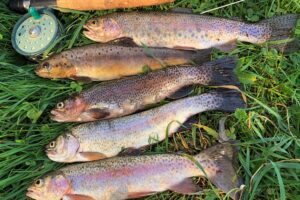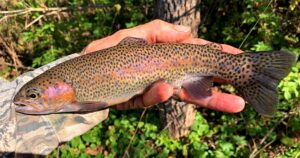Photography courtesy of Lowell Washburn, all rights reserved.
Mc Gregor — For anyone wishing to broaden their enjoyment of fall color, I would strongly recommend a trip to the bluff country of extreme northeast Iowa. Famous for its picturesque stands of majestic hardwood timber, people annually drive from far and wide to view the region’s rich mosaic of red, yellow, and orange autumn foliage. But the fall color I’m thinking of it something different. Instead of leaves and bark, this color has fins and scales.
In addition to its rich timberlands, grazing dairy cattle, and scenic vistas, Northeast Iowa is also trout country. And there is no better time to sample this amazingly colorful fishery than right now.

Iowa trout fishing has changed dramatically over the years. At a time when relentless human pressure seems to push many of our natural resources to the limits of their endurance, trout fishing just keeps getting better and better. When I began trout fishing during the mid-1960s, there were only three known populations of wild trout. All three populations were stressed. Two were threatened. Consequently, our trout fishing was solely dependent upon weekly stockings of hatchery produced, catchable sized rainbow trout. Although stocked, put-and-take trout provided Iowans with countless hours of outdoor recreation, there was also a downside. Wherever the stocking trucks went, crowds followed. Stocked pools quickly became angler congested. Hatchery produced trout lacked the legendary wariness of their wild counterparts and were as willing to feed on oil packed salmon eggs and Velveeta cheese balls as they were on natural foods.
But times have changed. And although the DNR continues to annually release around 400,000 hatchery reared, catchable-sized trout, there are also a host of previously nonexistent options. Today, Iowa anglers enjoy unprecedented opportunities to pursue totally wild trout in pristine rural settings. The number of spring fed, cold water streams currently harboring populations of completely wild, self-sustaining trout has soared from those three known waters to more than fifty. Wild browns are the dominate species in most of those streams, with naturally reproducing brook trout coming in second. Fish of all sizes occur within these natural environments; and DNR electro-fish surveys have revealed that it is not uncommon for populations to exceed an incredible 500 to 1,000 trout per mile. In Allamakee and Clayton counties, local anglers tell me that it is now possible to encounter brown trout – some exceeding 16 to twenty inches — in virtually every cold water stream the region has to offer.
Iowa trout waters come in all shapes and sizes. Some streams are but a few inches deep and less than six feet wide. Others are broad and contain dark pools too deep to wade. Like the anglers who stalk their pools, runs and riffles, each stream has its own unique personality — some special feature that makes it stand out from all the others.
A few seasons back, I enjoyed a chance encounter with another angler while fishing a lively stretch of water near Manchester. After exchanging pleasantries, we decided to break for a chat.
The man’s name was Ed Perkins. Perkins was an English doctor who, upon retirement, had moved to America to accept a teaching stint at the University of Iowa. It didn’t take long to realize that the good doctor was a genuine trout fishing addict who had plied the waters of several countries on three continents. I was naturally a bit surprised when this world traveler told me that Iowa streams were among his favorites, and that the fisheries clustered within our limestone blufflands compared favorably with the best chalk streams of his native England – the literal birthplace of the art of fly fishing. Although I never crossed trails with Perkins again, our conversation left me with a deeper sense of appreciation for the incredible natural resources readily available to everyday Iowans.
Although I enjoy trout at any season, fall fishing is my definite favorite. The weather is beautiful and as a rule, you’ll have a good stretch of stream all to yourself. While fishing on two popular public areas a couple of days ago, I never encountered a single angler on either stream. As always, the trout were abundant, though challenging. But sensing that winter could be just around the corner, some of the fish seemed to have lost at least some of their usual wariness.
The first fish I creeled was a fat eleven-inch rainbow that I hooked on the second cast. Next, I attempted a second fish after watching it inhale three of something off the surface. After making my cast, I could see the trout rise to the occasion, inspect, and then reject my offering before sinking back to where it had been holding.
Moving on, I fished a broad run without sighting any fish. Rounding a sharp bend in the steam, I suddenly came upon a picture-perfect scene. At the head of a rock-strewn riffle, the stream necked down to perhaps seven feet in width. The constriction caused the water to instantly gain enough velocity to produce a rushing gurgle as it cascaded over and around the rocks. On the opposite bank, a rock laden mossy undercut offered shade and concealment. It was everything a trout could want — elevated oxygen, a first crack at whatever food the speeding current might deliver, and safe energy saving cover from which to launch an ambush. It would seem impossible for such a place to not hold a fish.
But although the setup was indeed beautiful, it also presented an angling challenge with no chance for error. Because of the stream’s extremely narrowed width, there was no room for a potentially fish spooking practice cast. Instead, the first cast would have to be on the money. After ‘thinking it through’ a few times, I finally made the cast.
Although I love trout and trout fishing, I’m not exactly Brad Pit when it comes to handling a flyrod. The cast wasn’t perfect, but it was close enough. Once the line hit the water, it didn’t drift for more than two or three seconds before the leader surged forward. Setting the hook, it was “fish on”. The rod tip arched into the classic U as a beautiful wild brown headed for parts unknown. When I finally got my hands on the fish, I was – as always – completely awed by its stunning perfection. The contrasting combination of tan, sienna, and crimson markings defied adequate description. Spectacular in every detail, the fish presented a vivid reminder of why fall is my favorite time for pursuing Iowa trout.



 Tom Cope
Tom Cope Sue Wilkinson
Sue Wilkinson Susan Judkins Josten
Susan Judkins Josten Rudi Roeslein
Rudi Roeslein Elyssa McFarland
Elyssa McFarland Mark Langgin
Mark Langgin Adam Janke
Adam Janke Joe Henry
Joe Henry Kristin Ashenbrenner
Kristin Ashenbrenner Joe Wilkinson
Joe Wilkinson Dr. Tammy Mildenstein
Dr. Tammy Mildenstein Sean McMahon
Sean McMahon